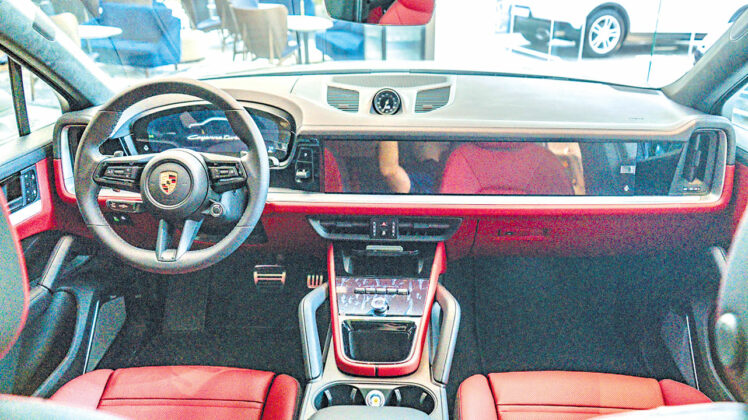The most powerful Porsche Cayenne ever is also a plug-in hybrid
By Kap Maceda Aguila
THE CAYENNE SUV was, once upon a time, a savior of the Porsche brand that had always been noted for its beautiful and powerful cars but never quite appealed to the pragmatic set and hence, never generated meaningful sales numbers.
Now 22 years old, the nameplate, together with its smaller Macan sibling, have continued to be a more practical choice to those who know what the Stuttgart-headquartered brand stands for, but also need their druthers in practicality. It’s a gift that keeps on giving for Porsche.
Last year, the brand delivered, by its own reckoning, 320,221 vehicles worldwide — three percent more than in 2022. Of this, the Cayenne accounted for 87,553 units. Even as this number represents a contraction of eight percent (with the decline “explained by the model change — including the staggered launch of the new generation worldwide since the market launch in April, as well as a software update for the hybrid models to ensure the best possible quality,” reported Porsche) the Cayenne was still the top-selling nameplate.
Speaking of hybrid, Porsche had long been working on an electrified powertrain for the Cayenne. It first floated the idea in 2005, before presenting a Cayenne Hybrid at the IAA 2007; a production-version traditional hybrid was rolled out in 2010. Four years later, the Porsche Cayenne S E-Hybrid (a PHEV) followed suit.
That last model has now been supplanted by the Porsche Cayenne Turbo E-Hybrid. Available in SUV and Coupé forms, it is said to be the “crowning touch” of the Cayenne model line, boasting a robust V8 engine supplemented by an electric motor. The plug-in hybrid electric vehicle (PHEV) has 729hp and 950Nm on tap, and Porsche said that the new hybrid technology it banners helps the vehicle realize “greater electric range” and “faster charging.”
PGA Cars is now making available this model to Filipino customers — the first time local car buyers can get their hands on an electrified Cayenne, which charts the nameplate’s path into a new chapter that is more eco-conscious, while simultaneously pushing the envelope of performance.
This, of course, is in line with the overall strategy of the sports car brand to systematically electrify its vehicle portfolio. Reuters reported that the Porsche brass has committed to realize 80% of sales from electric vehicles (EVs) by 2030. Only the iconic 911 is expected to remain internal combustion engine (ICE)-powered in the foreseeable future, a top executive had said.
Still part of the nameplate’s third generation, the new Porsche Cayenne Turbo E-Hybrid surpasses the abilities of the aforementioned Cayenne S E-Hybrid as engineers succeeded in “achieving significant gains in electric range and performance.”
Total system output includes 130kW (176ps) from the electric motor, adding to the “extensively reworked” 4.0-liter twin-turbo V8 mill which itself submits 599ps. All these numbers translate to, among other performance attributes, a standstill-to-100kph time of 3.7 seconds — onward to a top rate of 295kph.
As a PHEV, the Porsche Cayenne Turbo E-Hybrid, maintains Porsche, offers up to 82km of pure electric range — also due in part to a higher-capacity battery (rated at 25.9kWh). A new 11-kW onboard charger can fill up that battery with juice in as little as 2.5 hours.
Another model highlight is adaptive air suspension, featuring new two-chamber, two-valve technology — leading to increased comfort and safety. The tech allows for the adjustment of the rebound and compression stages of the suspension — itself “(combining) confident handling in dynamic cornering with comfort-focused characteristics in slow driving situations and maximum suppression of pitch and roll. Porsche Torque Vectoring Plus (PTV Plus) is also standard in the Cayenne Turbo E-Hybrid. Porsche Dynamic Chassis Control (PDCC) and rear-axle steering are available as options,” explained PGA Cars.
Among aesthetic changes — also resulting in enhanced performance — are Turbo-variant-specific front-fascia styling: larger cooling air intakes with gloss-black airblades, trims on the wheel arches, body-colored rear bumper, and two twin tailpipes in brushed stainless steel.
In the cabin are aluminium inlays in the dashboard and the door panel; the roof lining is in Race-Tex material. The Turbo E-Hybrid receives a GT sports steering wheel, a mode switch for fast and direct selection of the desired driving mode, and 18-way adjustable leather sports seats. Fourteen-way adjustable leather comfort seats are also available.
The model also reflects updates to the nameplate made last year: an all-digital instrument cluster in a curved and free-standing design with variable display options, a redesigned center console, and an optional passenger display. Its signature four-point high-resolution HD-Matrix LED headlights “offer greater comfort and safety in the dark.”








